The Ultimate Guide to Marquise Cut Diamonds
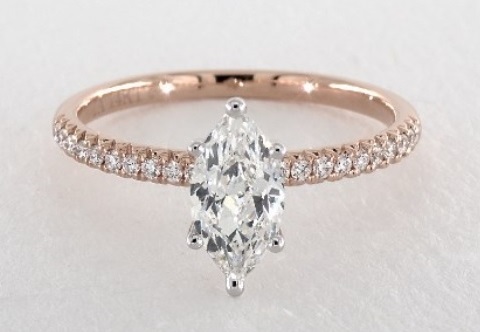
A magnificent marquise cut diamond engagement ring in 14k rose gold.
The marquise diamond (a.k.a. navette cut) is a type of modified brilliant cut that resembles an American football. With its long and slender shape, it has a unique appeal that is well-received by people looking to make a fashion statement.
Besides portraying an elegant appearance, one main benefit of the marquise cut is that they appear bigger when compared to other diamond shapes with similar carat weights.
The marquise brilliant cut diamond can have a varying amount of facets which depends on how it was cut (usually around 56-60 facets). This is due to the different faceting patterns where the pavilion section can be polished with four, six or eight pavilion mains.
Here is a list of topics we will be covering:
- Ideal Proportions For Marquise Cut Diamonds
- Length to Width Ratios: Marquise Can Exist in Various Forms And Outlines
- Practical Issues to Be Aware Of When Buying a Marquise
- Bow Tie Effect in Marquise Diamonds – A Gentleman’s Predicament
- What You Need to Know About the Anatomy of a Diamond
- What to Look Out For in the Girdle Thickness of a Marquise Diamond
- Why is Symmetry an Important Factor in Marquises?
- How Much Does a Marquise Shaped Diamond Cost?
- 1 Carat vs 2 Carat Marquise Diamond Ring
- Well Cut Marquises vs Poorly Cut Marquises
- Best Marquise Cut Engagement Ring Settings And Designs
- Summary And Recap: How to Select a Marquise Cut Diamond
Ideal Proportions For Marquise Cut Diamonds
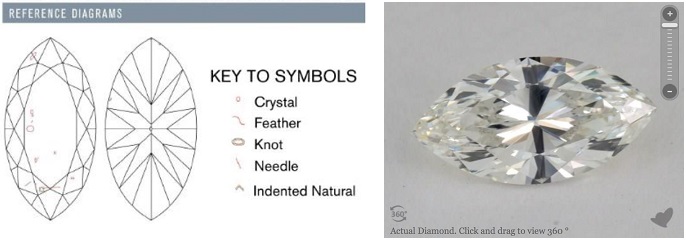
The marquise cut diamond above is an example of one with 8 pavilion mains in its facet pattern.
Due to their fancy, elongated shape, it’s tricky to determine the cut quality and light return of a diamond based on a set of “ideal proportions” alone.
Below is a table of recommended proportions that I’ve compiled based on my experience with handling well cut marquise diamonds but these “best proportions” should not be taken as a hard and fast rule.
Bear in mind that it should only serve as a rough guideline to help you weed out poorly cut diamonds. Ultimately, you will need to rely on unbiased videos taken in neutral lighting to help you assess the cut quality of a marquise.
| Excellent | Very Good | Good | Fair/Poor | |
|---|---|---|---|---|
| Table % | 55% – 62% | 53% – 64% | 52% – 65% | Outside Ranges |
| Depth % | 58% – 64% | 56% – 66% | 55% – 68% | Outside Ranges |
| Polish/Symmetry | Excellent – Very Good | Good | Outside Ranges | |
| Length to Width | 1.70 – 1.80 | 1.60 -1.90 | 1.40 – 2.10 | Outside Ranges |
| Girdle Thickness | Thin – Slightly Thick | V. Thin – Very Thick | Outside Ranges | |
| Culet Size | None | Very Small | Small | Outside Ranges |
* Note: The above table should be used as a reference only. When dealing with fancy cut diamonds, numbers only serve as a useful guideline to follow if you are buying blind. Nothing beats a visual examination either in person or via a video. Also, I highly recommend using an ASET to evaluate the diamond’s optical performance.
Length to Width Ratios: Marquise Can Exist in Various Forms And Outlines
In the market, you can easily find marquises that have various outlines due to the different length to width ratios they are cut to. Personally, I prefer marquises that have a l/w ratio within the “goldilocks” range of 1.70 -1.80 as they look just right.
If the l/w ratio is too long, the stone will take up a “malnourished” look. Vice versa, if it is too short, the marquise will look like a squashed and deformed oval. That said, beauty lies in the eyes of the beholder.
It is perfectly OK if you think a marquise with l/w ratio of 2.30 looks great and you should make choices based on your preferences.
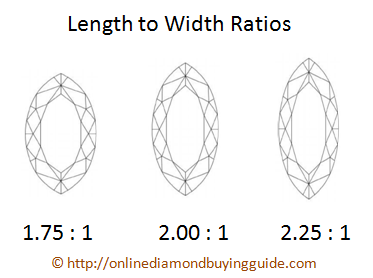
To help you visualize how diamonds with various length to width ratios may look like in real life, you can use the following photographs as a reference.
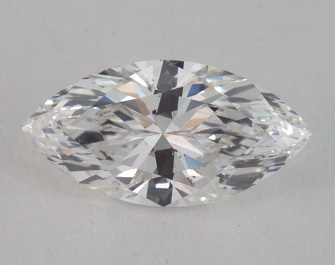

Both diamonds above have a l/w ratio that is close to 1.75:1 and I love the pleasant outlines they portray.
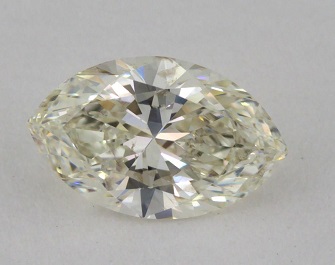

With a shorter 1.6:1 ratio (diamond on the left), the marquise appears squashed and can be mistaken to be a deformed oval shape. On the other hand, when the length-width ratio is too high (1.98:1 for the diamond on the right), the diamond’s outline becomes very awkward.
In both of these extreme cases, the diamond’s brilliance and structural integrity can be negatively affected.
Practical Issues to Be Aware Of When Buying a Marquise
#1: Stay Above an SI1 Clarity Rating to Get an Eyeclean Diamond
With marquise cut diamonds, they tend to do fairly well in hiding inclusions when they are well cut. This means you don’t have to pay a premium for high clarity ratings as most diamonds in the lower clarity tiers are eyeclean.
As a general guideline, I recommend at least an SI1 rating as they will usually have unnoticeable inclusions to the naked eye. For example, this VS1 marquise costs $4,990 while this SI1 marquise costs only $4,130 and they both have no visible blemishes.
That said, it is important to review each diamond based on its own merit and the best way to do this is to utilize magnified videos or high-quality photography. James Allen and Blue Nile are vendors that excel in providing HD videos to help you make informed decisions.
#2: Marquises Require Higher Color Ratings to Face Up White

Like many other fancy shapes, marquises tend to absorb and reveal their inherent body color. More notably, the diamond’s color tends to concentrate near the tips. If you are a color adverse person, my advice is to select diamonds with G or better color ratings.
Note: If you are buying bigger sized stones (e.g. >1.50 carats), the color will stick out even more and it is easier for the eyes to discern yellow nuances. To achieve an white icy look in larger diamonds, I recommend buying within the colorless grades of D-F instead.
#3: V-Prongs Are Required to Protect the Vulnerable Tips
Even though diamonds are the hardest substance on Earth, they are brittle and can be chipped when an excessive force is applied. In a marquise shape, the 2 pointed tips are especially vulnerable to damage and special care is required to protect them.
When choosing a setting for a marquise diamond, my recommendation is to select one that has two V-shaped prongs properly positioned to safeguard the tips.
From a practical point of view, most people don’t know that the two pointed ends of a marquise ring can easily catch onto things. If your recipient is a relatively careless person or regularly performs heavy work, a marquise might not be the best shape for her.
Bow Tie Effect in Marquise Diamonds – A Gentleman’s Predicament

An ugly marquise that is dark and lifeless throughout.
Whenever we deal with fancy shapes where the length of the diamond is greater than its width, it is hard to maintain an even distribution of light within the stone. This results in a phenomenon which manifests itself as a bowtie (dark looking patches) across the diamond’s mid-section.
The bow tie effect is most noticeable when the diamond is observed from a 90 degrees head-on view and is usually pronounced in diamonds with shallow depths (since proportions of the pavilion main facets largely influence it).
Is Having a Bowtie All That Bad?
It depends. I find that having some degree of a bow-tie can actually be a good thing as it adds contrast to the diamond’s scintillation pattern. On the other hand, if the bowtie is too pronounced, it can be detrimental to the diamond’s appearance and make it unappealing.
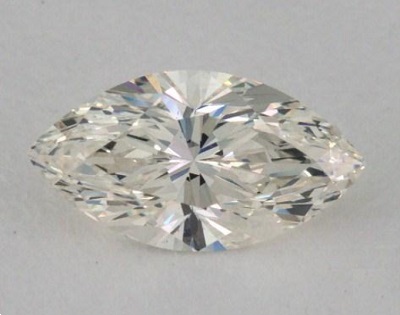
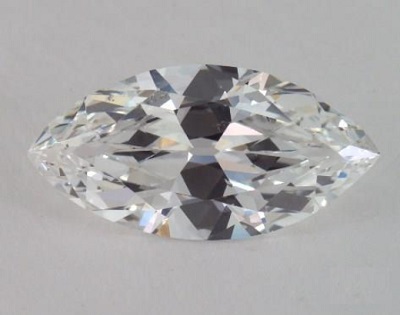
Which would you choose? I think the choice is pretty clear!
More Examples of Marquise Diamonds With Bowties
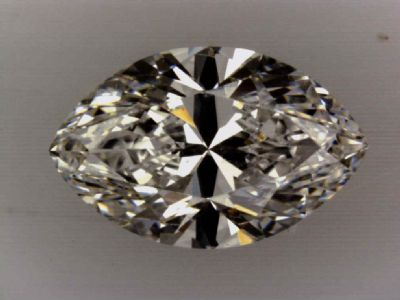
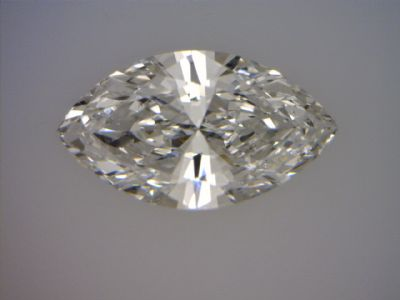

In the examples above, we can see varying intensities of the bow tie effect from a face-up view. Obviously, a dark black bow-tie is undesirable and the example on the far left is what you want to avoid.
While the ones in the middle and the right looks OK in the photographs, it still doesn’t tell you the full story about the diamond. To me, passing a check for bowties is a prerequisite but it doesn’t automatically qualify the diamond as a keeper.

Poor light distribution within this diamond results in many dark looking areas.
You Need to See It With Your Own Eyes!
At the end of the day, bowties are a subjective issue in which you have to make decisions yourself. It is best to observe diamonds physically where you can tilt and examine the stone at different angles to see how the bow-tie interacts with light.
With that said, I am sure the following questions are probably on your mind now:
1) My local store only carries 2 marquises in stock. How do I make good comparisons and come up with a sound judgment when I am only limited to two choices?
2) The marquises I see in stores are usually above 1 carat or out of my budget range. Where can I find one that is beautifully cut and falls within my budget?
Here’s an industry fact: more than 90% of fancy cut diamonds have dismal light performance and proportions. For a diamond shopper, the odds of finding a well cut diamond from 2-3 choices are stacked against your favor.
That’s why the best method of buying fancy shaped diamonds is to shop online. The reason is simple. Online shopping is the only method where you can easily access thousands of diamonds for cherry picking.
What You Need to Know About the Anatomy of a Diamond
Before we can talk about the issue of symmetry and girdle thickness, we first have to understand what makes up a diamond’s anatomy. The various parts of a diamond can be broken down into three main portions:
- the crown is the top part of the diamond. It consists of bezel facets, upper girdle facets and a large horizontal facet at the diamond’s center called the table.
- the girdle refers to the rim (outer circumference) of the diamond. Its primary role is to prevent chipping during the setting process.
- the part below the girdle is what we call the pavilion. This is where all the magic actually happens; where light is reflected back through the top of the diamond to appear as fire and scintillation.
What to Look Out For in the Girdle Thickness of a Marquise Diamond
When you see a diamond that has a “very thin” or “extremely thin” girdle, you need to exercise extreme caution. Diamonds with very thin girdles are very susceptible to chipping during the setting process and normal daily wear.
In the example below, I had circled the portion of the diamond where the girdle thickness is going to be a major durability issue. To get a better idea of what I am talking about, do click on the corresponding links and view these diamonds under high magnification.
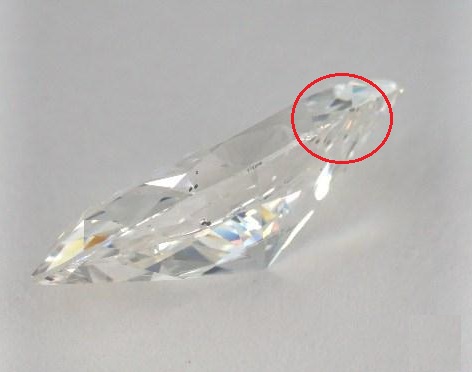
This particular diamond has an extremely thin – slightly thick girdle.
As I had mentioned before, the most vulnerable locations of a marquise diamond are found at its two pointed ends. In the following example, you can see that the girdle area at the tips is not thick enough to provide sufficient mechanical strength.
A slight knock at the correct angle can cause significant damage and makes this diamond a very risky purchase. And if you look closely at this particular example, you can already see that parts of the girdle have already been damaged.

The very thin girdle thickness at the tips makes this stone a poor choice.
Girdle Thickness Affects Spread And How Big the Diamond Faces Up
Marquises have better spread and tend to look larger than other diamond shapes with similar carat weights. If you are a smart shopper and want to get more value out of your purchase, look out for diamonds with medium to slightly thick girdles. This will help you avoid diamonds that have excess weight “trapped” within the girdle area.

Why should you pay for “dead weight” that can’t be seen from a face up view?
A Real Life Comparison of Diamonds With Different Girdle Thicknesses
To give you some perspectives on size and face up appearance, let’s take a look at the following diamonds:
#1: 0.81 Carat D Color VVS2 with a thin to slightly thick girdle. It measures up at 9.42 mm * 5.19 mm * 2.97 mm (L/W/D) and has a pretty decent face-up size for its carat weight.
#2: 0.82 Carat H Color SI2 with a very thick – extremely thick girdle. In contrast, this diamond measures up at 8.67 mm * 4.72 mm * 3.20 mm.
Both diamonds weigh approximately the same and yet the 0.80 carat stone faces up significantly smaller. Here’s another comparison of 2 stones with different girdle thicknesses.
– 0.46 Carat D Color VVS1 with a medium to very thick girdle that measures up at 8.05 mm * 4.19 mm * 2.41 mm
– 0.49 Carat D Color SI2 with a very thick to extremely thick girdle that measures up at 7.51 mm * 3.88 mm * 2.63 mm
Again, the sizes differ significantly and the lighter diamond actually looks larger!
Now, please don’t misinterpret my intentions about maximizing spread to the extent that you start choosing diamonds with extremely or very thin girdles. A safe girdle thickness that would ensure better durability lies in the range of thin to very thick.
Why is Symmetry an Important Factor in Marquises?

Lop-sided marquise diamond that doesn’t look good at all.
In my humble opinion, a diamond needs to be sparkly and be full of brilliance. However, a good diamond goes beyond that and only careful cutting can yield stones with character and enormous appeal.
By now, you should know that a marquise has the advantage of maximizing spread for its carat weight. However, this advantage comes at a price as marquises are very sensitive to symmetry details. As a result of poor cutting, a marquise can easily lose much of its shape appeal.
Here are more examples of marquises with symmetry issues and outlines you should avoid.

These images depict marquises with undesirable outlines and serve as a reminder to why shopping “blindly” is a bad idea. You need to understand that it is impossible to gauge the looks of a fancy shaped diamond based on its certification alone.
Sadly, I’ve seen it happened many times where eager shoppers buy solely based on a grading certificate only to be disappointed with the outcome. It’s always a roll of the dice when you shop blindly and you won’t know what to expect until it is too late.
Where Can Symmetry Flaws Occur in a Diamond?
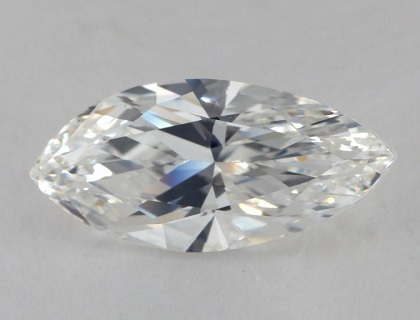
This ugly lop-sided marquise looks more like a pear.
Symmetry flaws are irregularities in the diamond’s cut and can occur as a result of many reasons. More notably, the presence of inclusions at undesirable locations and the decision to remove them often lead to intentional symmetry flaws.
This phenomenon happens because cutters are under immense pressure to polish rough diamonds for maximum weight retention and they often do it at the expense of cut.
Diamonds with poor symmetry also tend to exhibit a wavy girdle when viewed from its profile and these problems are so blatant they can be easily noticed by the unaided eye.
The main issue with such symmetry flaws is that it makes the setting process very difficult and also causes the diamond to appear out-of-shape.
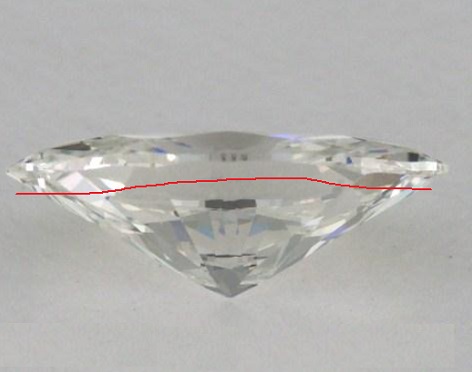
Notice how the red line I had drawn to follow this diamond’s girdle isn’t straight? Avoid at all costs!
How Much Does a Marquise Shaped Diamond Cost?
Compared to round cut diamonds, the prices of marquise-shaped diamonds are generally 20-30% lower. Not only are you able to buy a larger carat size diamond for less money, the elongated shape of the marquise also enhances the size of the diamond.
As a reference, I’ve compiled a price comparison chart to show you the prices of 1ct marquise diamonds and how they vary with color/clarity grades.
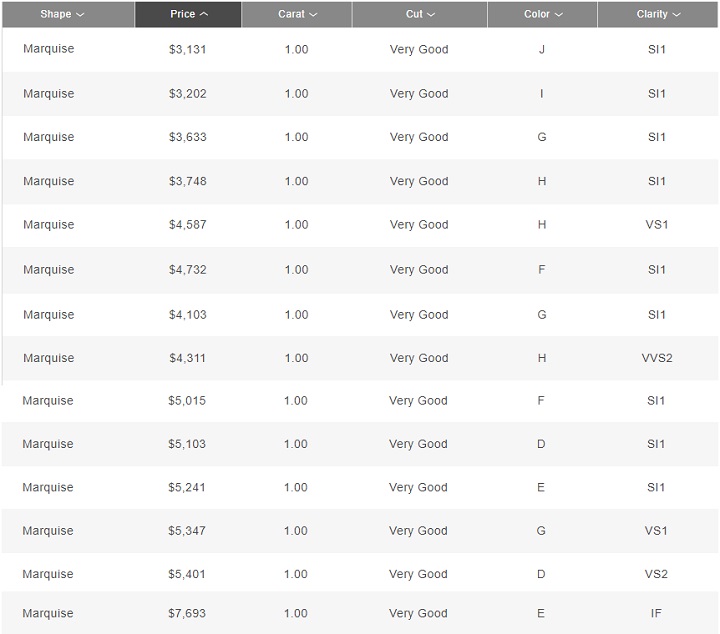
Price chart comparison of GIA certified 1ct marquise shape diamonds.
For a 1 carat size diamond, you can expect to pay between $3,000 to $8,000 for a diamond with decent qualities. Obviously, the higher the color/clarity grades, the more expensive the diamond will become.
Here, I want to point out that a diamond with higher color/clarity grades may not necessarily look better or be discernible from one with a lower color/clarity grade. For example, most people will not be able to notice visual differences between a well cut G/VS2 diamond when compared against a D/IF diamond.
However, the price differences would be very significant! So, if you are someone who is on a budget, consider going down in color or clarity grades to save money.
1 Carat vs 2 Carat Marquise Diamond Ring
When it comes to marquise cut diamonds, the most popular size is 1 carat because they are relatively more affordable compared to round diamonds.
The elongated outline of the marquise cut diamond offers good finger coverage even if you are someone with larger hands. To give you a better idea of real world appearances, here’s a comparison of a 1 carat marquise cut diamond ring vs a 2 carat marquise cut diamond ring.
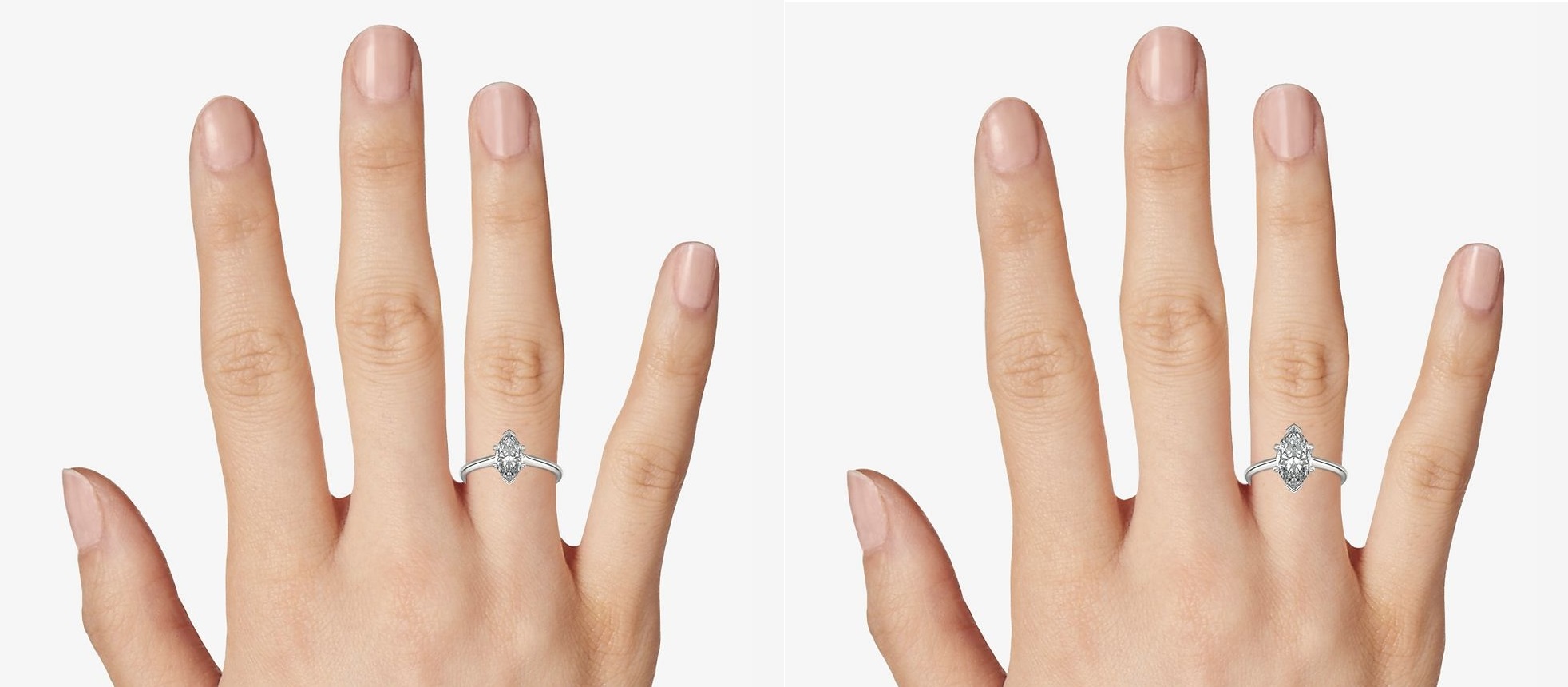
1 carat vs 2 carat marquise cut diamond ring on size 7 finger.
While the carat weight of a 2 carat diamond is twice that of a 1 carat diamond, the price differences differ in an exponential manner. As an example, this 1 carat, D color/VS2 clarity diamond costs $7,200 but the cost of a 2 carat, D color/VS2 clarity diamond can be 4 times more!
In terms of physical dimensions, the 1 carat marquise diamond measures up at 10.74 x 5.12 x 3.20 mm while the 2 carat marquise diamond measures up at 12.82 x 6.52 x 4.14 mm.
Well Cut Marquises vs Poorly Cut Marquises
In order to pick out well cut marquise diamonds that have strong light return and superb scintillation patterning, it does require some experience and knowing where’s the best place to shop.
Below are two examples of marquise diamonds that are purchase worthy by my standards. These are selected for their excellent shape appeal and light performance. Hopefully, this gives you a better idea of how the well cut marquises look like in real life.
I’ve also included a couple of badly cut marquise diamonds to highlight issues you should beware of when making a selection. Again, feel free to click on the images to interact with these diamonds for yourself.
Best Marquise Cut Engagement Ring Settings And Designs
If you are looking for ideas for a marquise cut diamond engagement ring, I’ve listed some of my favorite designs below. These are real life diamond engagement rings that other people had purchased.
Hopefully, this section here will provide you with some inspiration and help you find your own perfect engagement ring. If you are interested in finding out full details about any of the settings, simply click on the corresponding images to learn more…
A sleek and modern ring with intertwining shanks to symbolize everlasting love and unity.
This knife edge diamond solitaire offers an affordable yet evergreen looking ring design.
A vintage-inspired ring showcasing multiple diamonds in a stunning display of bezel and pavé settings.
Tapered pave shanks draw the attention of your eyes towards the center diamond in this beautiful ring setting.
Here are a couple more designs from Blue Nile that caught my eyes. Two things I love about them are their superb craftsmanship and highly affordable prices.
What I’ve shown you above are just a few designs out of 100s of available ring settings. If you want to see more engagement ring designs for marquise diamonds, head over to Blue Nile and James Allen to start browsing!
Summary And Recap: How to Select a Marquise Cut Diamond
To recap, here are my recommended guidelines for buying a marquise shaped diamond:
Depth: 58% to 64%
Table: 55% to 62%
Polish/Symmetry: Very Good or Excellent
Length to Width Ratio: Within a range of 1.70 to 1.80
Color: G or better
Clarity: SI1 or better
When you are shopping for marquise diamonds, it is imperative to view diamonds with magnified videos taken in neutral, fluorescent lighting. This will enable you to assess the diamond without bias and make better buying decisions.
Related Articles
Leave A Comment

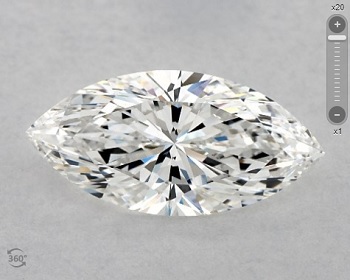
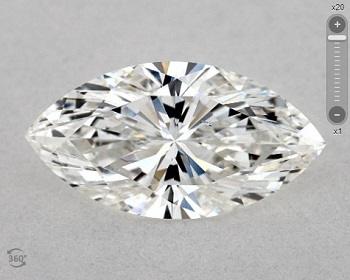






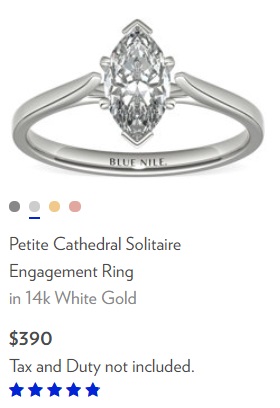



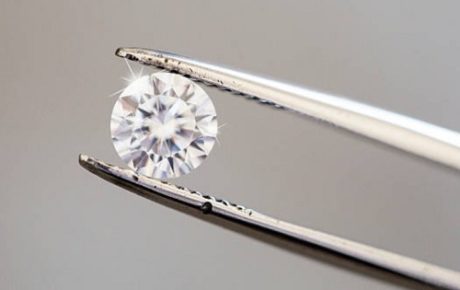
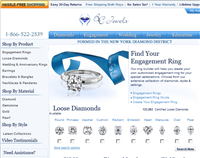
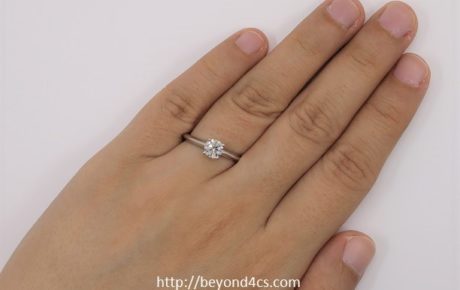









8 Comments
Will a marquise diamond look weird in a cathedral setting and do you have any vendors that you can recommend for custom made settings in Houston?
It depends on the carat size and overall design. Personally, I don’t see any issues with matching marquises to cathedral settings. If you are in Houston, you are in luck. White Flash is a vendor that you might want to check out. I did a write up about some of their cathedral settings recently in this article: https://beyond4cs.com/engagement-ring/what-is-a-cathedral-diamond-ring-setting-style/
Dear Paul,
I quite enjoy your blog, thank you for your hard work. I would appreciate your help please testing/challenging a concept that I have for an engagement ring. Please tell me if any elements of my plan are unrealistic. Your feedback will also help me drill down search criteria for a center Marquise stone.
1) I’ve attached a picture of my desired concept. It is a marquise flanked by 2 round stones. I plan to buy a marquise center stone from James Allen, and then find a local jeweler to build a custom ring.
2) I was gifted my mom’s engagement ring, from which I plan to remove and use and apply 2 small round stones towards the new ring. Each of these stones is 0.15 carats. (The desire for doing this is financial, so if you believe that the labor cost of doing this is not worth it, please let me know). The quality of these side stones is unknown, as they were not graded. As for an educated guess, the 2 side stones in question originally accompanied a round brilliant rated by EGL as “G-H” color and “SI2-I1.” This would lead me to believe that they would be equal or lesser quality than that, and I understand that EGL is not a top lab to begin with…
3) You taught me these are the recommended dimensions for a Marquise:
*Length to Width Ratio: 1.70 to 1.80 goldilocks range
-Table: 55% to 62% is ideal, 53% to 64% is good
-Depth: 58% to 64%% is ideal, 56% to 66% is good
4) A primary objective in construction of my new ring is congruence/harmony among the elements, while balancing cost (money is not an issue, but I like to use my money efficiently):
-For example, the size of the Marquise should LOOK proportional in comparison to two 0.15 carat stones. The concept photo I shared is an example of what looks proportional to me. Assuming the marquise had the recommend dimensions in point #3, and assuming that buying shy is a good strategy, what approximate carat size should I find for this ring?
-In terms of color and clarity, I would not want the Marquise to drastically overshine the side stones I plan to use (as the side stones would drag down the beauty of a too-perfect Marquise, which would be a waste of money). At the same time, I know that the Marquise, being a larger stone, must be at a minimum standard to remain eye clean. What color and clarity grades do you recommend for this ring?
5) I plan on a platinum band, similar to the studded one in the concept photo. My girlfriend has larger hands than most women (former basketball player), her ring size is 8, and her occupations is a caregiver for the elderly and hairstylist. I will V-prongs to protect the marquise tips. Please share any other band or setting recommendations based on description of girlfriend.
Again, I greatly admire you and I have spent hours studying your work and taking notes. Thank you in advance for vetting my concept. Please ask any clarification questions if needed.
If you intend to buy the diamond from James Allen (which I recommend because of their marquise selections), I would recommend buying the setting from the jeweler you buy the setting from. This reduces hassles, stress and MORE IMPORTANTLY, makes one jeweler responsible for the finished piece of jewelry.
In the unlikely event that the diamond chips during setting, no blame is going to be shifted around. It’s very very rare and I only had one case of the diamond chipping when JA set it. Of course, JA contacted the reader I helped and notified him. He was given the option of a 100% refund or to choose another diamond. It’s a slight inconvenience when rare things happen BUT you want to be sure that the jeweler will take care of you.
You probably don’t get protection like this done if you go your route.
Without seeing the ring in person, I can only give an educated estimate. The marquise is about 1.2-1.4ct in size if the sidestones are 0.15ct.
Get a G/H VS/SI1 diamond. That will give you the best value for money.
In terms of settings, it is largely a personal choice. All marquise set diamond rings will be v-prong set. I don’t see any jeweler who doesn’t do that in the market. So, no worries there. And I’m afraid, settings are something I cannot help you with. What I like doesn’t equate to what she likes. And that’s the key. What does she likes?
I can help you with finding a diamond if you need. Just let me know a realistic budget to work with and I can find the best cut marquises for light performance for you.
Hi, I am considering a marquise. Quick question: does a depth of more than 64% cause shadows in a marquis? I found a diamond I like, but the depth is 67.5%. The girdle is thick to very thick. It is hard to find a diamond with a thin to thick girdle. Will the thicker girdle offset the depth? Thank you.
It depends on a case by case basis. I’ve said this explicitly, the proportions cannot be used as a standalone to pick out a diamond. When you say shadow, I am assuming it means the bowtie and a video of the diamond would allow you to see how severe it is. As for girdle, the thick to very thick girdle is not a cause for concern.
Hi Paul.
Thanks for all the help on your website, it’s really awesome!
As a lot of people browsing your website I am looking for a ring hahaha.
I know by asking friends of my girlfriend that she particularly likes the marquise shape. It seems that there are not as many “info” about marquise cut compared to other shapes. Especially the “cut” part; the option gets deactivated on James Allen website. There is also this “bow-tie” effect that makes things more complicated. I have a budget up to 4k for the diamond and no real preference for the size as long at it looks great.
I was looking at this one: https://www.jamesallen.com/loose-diamonds/marquise-cut/0.75-carat-d-color-vvs1-clarity-sku-8496676
What do you think?
Thanks so much for the help and for all the work you do!
I reviewed the diamond here: https://www.jamesallen.com/loose-diamonds/marquise-cut/0.75-carat-d-color-vvs1-clarity-sku-8496676
I can confirm that the diamond is well cut and has strong light return. The bow-tie in this marquise is pretty faint and the scintillation patterning is great. Overall, it’s a well selected diamond and it shows me that you know what you are doing. Go for the diamond. It’s a great buy.